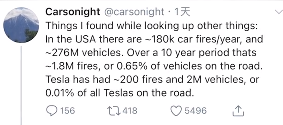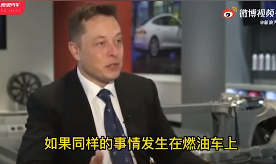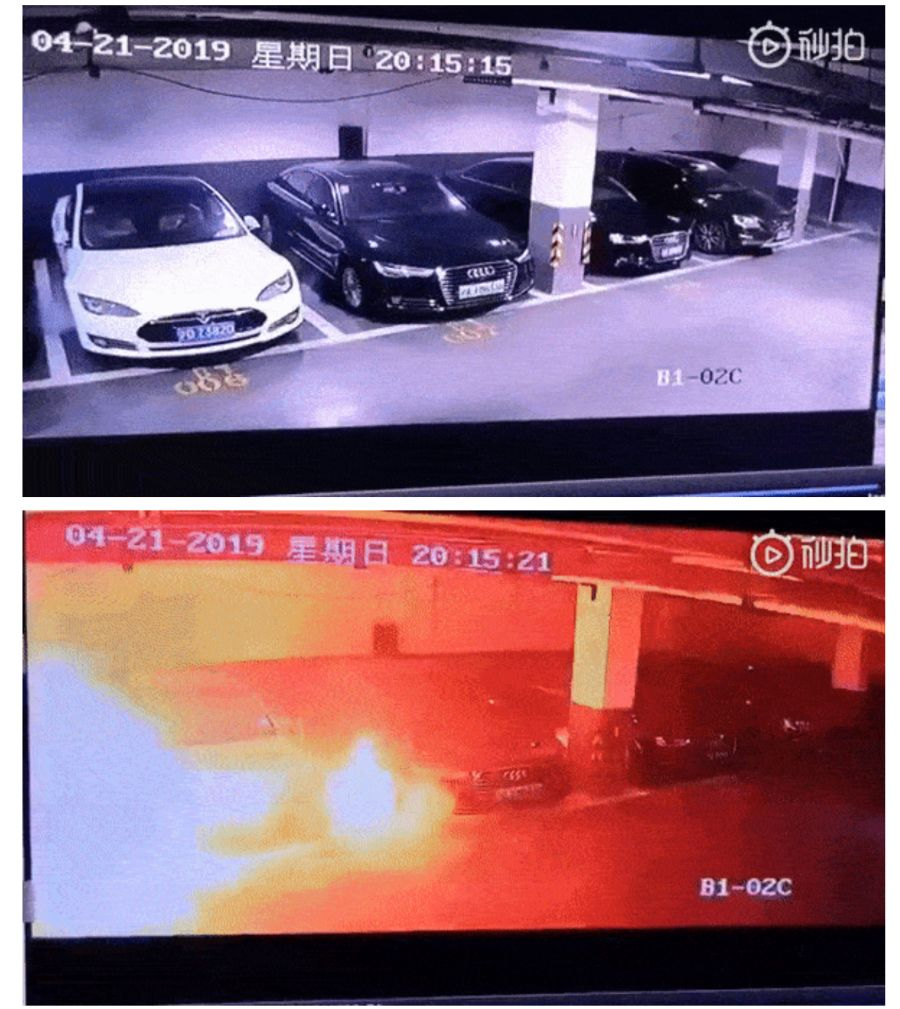In addition to Weibo, there is also WeChat
Please pay attention

WeChat public account
AutoBeta


2024-11-17 Update From: AutoBeta autobeta NAV: AutoBeta > News >
Share
AutoBeta(AutoBeta.net)09/24 Report--
Recently, some netizens on foreign social platforms posted that the annual spontaneous combustion rate of fuel vehicles in the United States is 0.65%, while that of Tesla is only 0.01%. Musk replied: "Don't be surprised, after all, there is fuel in the name of the fuel car."


Prior to this, Musk had said publicly: "if Tesla's accident happened on a fuel truck, the consequences would be even worse." It is worth noting that a suspected spontaneous combustion of a Tesla electric car occurred in Shanghai on April 21, 2019, when a 2016 Tesla Model S "static spontaneous combustion" occurred in an underground parking garage in Shanghai. After the incident, Musk publicly said that Tesla was far less likely to catch fire than fuel-fueled cars, saying: "the reality is that Tesla, like most electric cars, is 500% less likely to catch fire than internal combustion engines." this is because the internal combustion engine carries a lot of flammable fuel, why no one mentioned this. " With regard to Musk's view, Yang Yusheng, academician of the Chinese Academy of Engineering, said at the 2019 New Ecological Industry Summit on key automobile components that Musk had "played a trick" on the issue and was "deliberately confusing the public". Academician Yang said that the current number of new energy vehicles is still relatively small compared with fuel vehicles, so there is an order of magnitude gap in calculating the spontaneous combustion probability. And the two kinds of vehicles are very different in terms of core power, design and related parts, electric vehicles have more lines and more heat transfer and emission scenes, so direct data comparison is not appropriate.

It is worth noting that in recent years, fire incidents of new energy vehicles have occurred frequently, and safety issues have also attracted the attention of consumers. Many brands of new energy vehicles have successively caught fire and spontaneous combustion accidents have become the focus of new energy vehicles, and many brands have recalled their own products. On June 27th, 2019, Xilai issued a recall notice that ES8 recalled a total of 4803 vehicles due to battery package safety problems. NIO said that after investigation, it was found that the battery pack used in the vehicle involved was equipped with a module with a specification model of NEV-P50, and the voltage sampling harness in the module was likely to be squeezed by the cover plate on the module due to individual improper direction. In extreme cases, the insulating material on the surface of the extruded voltage sample harness may be worn, resulting in short circuit and safety risks. On July 16, 2021, Chery recalled 1407 Chery Erize 5e electric vehicles because of possible consistent fluctuations in the assembly of some parts in the power battery. After the vehicle has been used for a long time, the bottom of the vehicle is subjected to abnormal impact or severe bumpy impact, in extreme cases, the high voltage connection of the battery package system is loose, the local contact internal resistance is increased, and the components are overheated and the battery is baked when the high current is used. this may cause the battery heat out of control, there is a safety hidden danger. Great Wall Motor filed the relevant announcement on the recall of Ouler IQ cars to the State Administration of Market Supervision and Administration on July 16, 2021, and decided to recall a total of 16216 Great Wall IQ electric vehicles manufactured from July 7, 2018 to October 30, 2019. The reason for the recall is that there is a matching difference between the consistency of some power batteries carried by the vehicle and the control strategy of BMS software. After long-term continuous and frequent fast charging, the performance of the battery decreases, and in extreme cases, the power battery may be out of control and there is a hidden danger of safety.

It is not difficult to see that under the dual promotion of consumer demand and state policy subsidies, the pursuit of high mileage of new energy vehicles has led to a continuous increase in battery energy density, and most new energy vehicles use ternary lithium batteries. Lithium is a very active metal that reacts with oxygen and burns once exposed to air. Lithium battery drum bag, foreign body puncture, external force impact, internal short circuit and overcharge discharge are all likely to catch fire. For both consumers and manufacturers, both sides hope to keep the vehicle accident rate to the lowest. With the gradual maturity of the electric vehicle market, "battery safety" is also a problem that manufacturers must solve. From the technology to continuously improve the safety design of new energy vehicles. For the car itself, any index is not as important as safety, safety is the first!

Although judging from the data released by netizens this time, Tesla is indeed safer than traditional fuel vehicles, but it is obviously not advisable to compare the spontaneous combustion rate of one brand with that of the whole market. For car owners, no matter how low the vehicle spontaneous combustion rate is, once the spontaneous combustion occurs, the consequences will be unimaginable.
Welcome to subscribe to the WeChat public account "Automotive Industry Focus" to get the first-hand insider information on the automotive industry and talk about things in the automotive circle. Welcome to break the news! WeChat ID autoWechat
Views: 0
*The comments in the above article only represent the author's personal views and do not represent the views and positions of this website. If you have more insights, please feel free to contribute and share.











© 2024 AutoBeta.Net Tiger Media Company. All rights reserved.